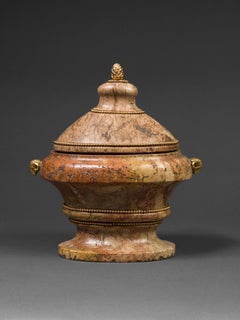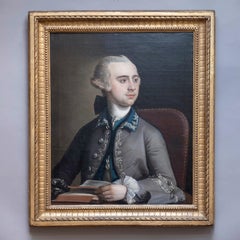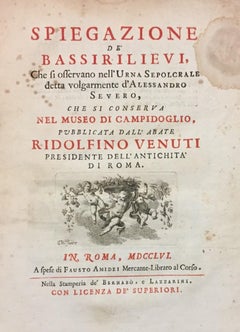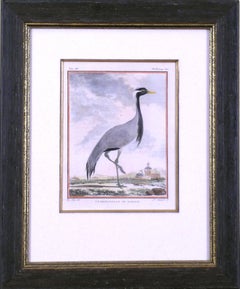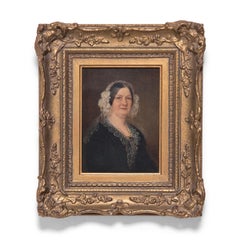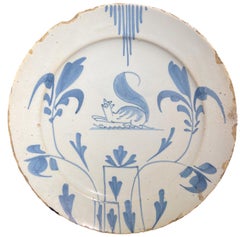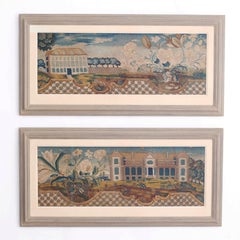Mid-18th Century More Art
to
6
2
7
1
5
2
1
Overall Height
to
Overall Width
to
1
1
209
500
4,850
10,598
68
79
242
307
146
312
361
369
428
1,545
106
2
1
4
2
2
2
2
Period: Mid-18th Century
Louis XV Wood Carved and Gilt Frame
Located in Madrid, ES
LOUIS XV WOOD CARVED AND GILT FRAME
Interior measurement: 57 x 110 cm.
Exterior measurement: 84 x 137 cm.
Category
Mid-18th Century More Art
Materials
Wood
Mid 18th century Rococo Chinoiserie Corner capboard with Exotic Flowers and bir
Located in Firenze, IT
This wall corner capboard is painted with chinoiserie ornaments.
With exotic flowers, plants, birds and insects.
Most likely inspired by drawings on Chinese porcelain.
Some touch-ups...
Category
Rococo Mid-18th Century More Art
Materials
Wood, Lacquer, Oil
18th Century Italian Pink Marble Urn with lid and bronze mounts
Located in Milan, IT
Typical of 18th Century Rome, this fascinating pink marble urn with lid is a wonderful example of Italian decorative arts. Embellished with bronze moun...
Category
Mid-18th Century More Art
Materials
Marble, Bronze
Henry Pickering, Portrait of a Gentleman
Located in London, GB
Henry Pickering, Portrait of a Gentleman
Oil on canvas; signed and dated 1759; held in a giltwood period frame
Provenance: Lenygon & Morant Ltd. c.1900; Knoedler, October 1912 (Sto...
Category
Old Masters Mid-18th Century More Art
Materials
Oil
Spiegazione de' bassirilievi dell'urna detta d'Alessandro Severo - 1756
Located in Roma, IT
Cover on cardboard and decorated in quite good conditions. Lightly damaged on spine. Inside quite good conditions except foxing on right side of some pages. quite fresh prints. Inclu...
Category
Modern Mid-18th Century More Art
Materials
Paper
La Demoiselle de Numidie (Crane)
Located in Florham Park, NJ
George-Louis Leclerec, Comte de Buffon.
HistoireNaturell, Generale et Particuliere avec la Description du Cabiner du Roi.
Paris, 1749
Drawings by Jacques E. DeSeve.
Engravings with l...
Category
Academic Mid-18th Century More Art
Materials
Watercolor, Engraving
Le Cygne (Swan)
Located in Florham Park, NJ
George-Louis Leclerec, Comte de Buffon.
HistoireNaturell, Generale et Particuliere avec la Description du Cabiner du Roi.
Paris, 1749
Drawings by Jacques E. DeSeve.
Engravings with l...
Category
Academic Mid-18th Century More Art
Materials
Watercolor, Engraving
Il Gazzettiere Americano - Ancient Illustrated Book on the Americas - 1763
Located in Roma, IT
3 volumes. Engraved title vignettes, 78 engraved plates and maps by Giuseppe Pazzi (including engraved frontispiece, 20 folding maps, 19 maps, 35 plates, 3 folding views). Half-title...
Category
Mid-18th Century More Art
Materials
Paper, Etching
Related Items
Portrait of a Lady in Red Dress on Porch c.1680, English Aristocratic Provenance
Located in London, GB
Presented by Titan Fine Art, this painting formed part of a historic collection of an English aristocratic family, Lord and Lady Sandys at their magnificent baroque and Regency Grade-I listed family home, Ombersley Court. The house was among the most fascinating survivals of its kind in this country. The atmospheric interiors were distinguished above all for the works of art associated with two key moments in national history. The collection was acquired or commissioned over five centuries and remained at Ombersley Court until its recent sale, the first in 294 years. This portrait hung in the Grand Hall.
This exquisite grand manner work is an evocative example of the type of portrait in vogue during a large part of the seventeenth and eighteenth centuries. The artist has depicted an elegant lady, three quarter length and seated on porch with a luxurious crimson swag curtain by her side. The clothing – known as “undress” at the time, consists of red silk fastened at the front and sleeves by large gold and diamond jewels over a simple white chemise. In her lap she holds a blue wrap and in her other hand, at her chest, she clutches the end of a sheer gauzy scarf that has been draped around her body with the other end a type of headdress – this type of sheer scarf was often employed by Wissing in his portraits. The classical architecture signifies cultivation and sophistication and the luxurious swag curtain is a signifier of wealth. The portrait can be dated to circa 1680 based on the sitter’s attire, the “hurluberlu” hairstyle, and other portraits by Wissing using the same formula.
This oil on canvas portrait has been well cared for over its life, which spans almost 350 years. Having recently been treated to remove an obscuring discoloured varnish, the finer details and proper colour can now be fully appreciated.
Once owned by Evesham Abbey, the manor of Ombersley was acquired by the Sandys family in the early 1600s, when Sir Samuel Sandys, the eldest son of Edwin Sandys, Bishop of Worcester and later Archbishop of York, took a lease on the manor, before receiving an outright grant in 1614. The present house, Ombersley Court, dates from the time of Samuel, 1st Lord Sandys, between 1723 and 1730. The house itself is a fine example of an English Georgian country house set in rolling countryside and surrounded by Wellingtonias, planted to commemorate the Battle of Waterloo by Arthur Hill, 2nd Baron Sandys, who played a distinguished part in the battle and was one of the Duke of Wellington’s aides de camp. The Duke also stayed in the house and in the Great Hall, was the Waterloo banner which was brought to the house by Sir Arthur Hill, aide-de-camp to the Duke of Wellington, who succeeded his mother, the Marchioness of Downshire as 2nd Lord Sandys. Further Waterloo memorabilia are kettle drums from battle. The family had a strong tradition of military and political service, dating back to the 17th century, and this was also reflected in the fine collection of portraits and paintings in the house. In short, Ombersley represented a vital aspect of British history. The house and more especially the collection were of the greatest historical importance. Houses that have remained in the possession of the same family for as many as three centuries have become increasingly rare.
Through this portrait, collectors have a chance to acquire a piece of British history and an evocative vestige of a glittering way of life, which is now gone.
Much of the attractiveness of this portrait resides in its graceful manner and the utter beauty of the youthful sitter. Presented in a beautiful carved and gilded period frame, which is a work of art in itself.
Willem Wissing was a Dutch artist who enjoyed a solid artistic training at The Hague under Arnold van Ravesteyn (c.1650-1690) and Willem Dougijns (1630-1697). He came to London in 1676 and most probably joined the studio or Sir Peter Lely as an assistant that same year. After Lely’s death in 1680 he effectively took over his business and he scaled the heights of patronage with extraordinary ease, creating an independent practise in 1687, and painted for very important aristocratic patrons. King Charles II was so impressed by a portrait Wissing painted of his son, the Duke of Monmouth, in 1683 that he commissioned his own portrait and that of his Queen Catherine...
Category
Old Masters Mid-18th Century More Art
Materials
Canvas, Oil
H 57.09 in W 47.25 in D 2.37 in
Oil Portrait of a Victorian Lady, c. 1850
Located in Chicago, IL
Painted in the 19th century, this exquisite miniature portrait wonderfully exemplifies realism in traditional oil painting. The small artwork is painted in the conventional portraiture style of the Old Masters, and achieves soft realism with fine brushwork and a subdued, neutral palette. The half length portrait depicts a fine Victorian woman dressed in all black with a delicate lace collar and bonnet. She wears a ruby broach...
Category
Old Masters Mid-18th Century More Art
Materials
Oil
Yayoi Kusama 'Pumpkin' Yellow/Black Pumpkin Pop Art Resin Sculpture, 2016
By Yayoi Kusama
Located in New York, NY
The ’Pumpkin' sculpture is a polka-dotted painted lacquer resin collectible art object by the legendary contemporary Artist, Yayoi Kusama. Published by Benesse Holdings, Inc., Naosh...
Category
Pop Art Mid-18th Century More Art
Materials
Resin, Lacquer, Acrylic
Free Shipping
H 3.75 in W 3.5 in D 3.5 in
Portrait of a Lady in an Elaborate Ruff & Lace Coif c.1610-20, Dutch Old Master
Located in London, GB
This magnificent oil on panel portrait, presented by Titan Fine Art, is a splendid example of the sumptuous female portraits that were painted for members of the upper echelons of society during the early part of the 1600’s. The artist has rendered this portrait with meticulous attention to detail and the surface effects of the fine materials. The elaborate lace coif and cuffs are painstakingly delineated, as is the bold black damask, and sumptuous gold decoration of her skirt and stomacher, which is wonderfully preserved and quite remarkable considering the age of the work and the fact that darker pigments are particularly vulnerable to fading and wear. This work with its spectacular depiction of costume is of absolute quality, it can be rated as one of the best works in the artist’s oeuvre and as such it is an important and splendid example of Dutch portraiture.
The Dutch Golden Age of painting was a period in Dutch history, roughly spanning the 17th century, in which Dutch trade, science, military, and art were among the most acclaimed in the world. Dutch explorers charted new territory and settled abroad. Trade by the Dutch East-India Company thrived, and war heroes from the naval battles were decorated and became national heroes. During this time, The Dutch Old Masters began to prevail in the art world, creating a depth of realistic portraits of people and life in the area that has hardly been surpassed. The Golden Age painters depicted the scenes that their discerning new middleclass patrons wanted to see. This new wealth from merchant activities and exploration combined with a lack of church patronage, shifted art subjects away from biblical genres.
Dress was a key component in portraits, and the exuberant attire reiterates the incredible wealth of this woman. The sitter will have visited the artist’s workshop and inspected examples on display. They would have chosen the size and the sort of composition and on that basis negotiated the price – which would have also been determined by the complexity of the clothing and the jewels that were to be depicted, and by the materials to be used. When all was considered, this portrait would have cost the sitter (or her husband) a substantial sum.
The colour black was regarded as humble and devout yet at the same time refined and sophisticated and the most expensive colour of fabric to dye and to maintain. Citizens spent fortunes on beautiful black robes. Such uniformity must also have had a psychological side-effect and contributed to a sense of middle-class cohesion; the collective black of the well-to-do burgess class will have given its members a sense of solidarity. The colour was always an exciting one for artists and when this portrait was painted there were at least fifty shades of it, and as many different fabrics and accoutrements. Artists went to great lengths to depict the subtle nuances of the colour and the fabrics and textures and how they reflected light and it was an ideal background against which gold and crisp white lace could be juxtaposed to dramatic effect.
The sitter is either a married women or a widower as is evident by the clothing that she wears and the position, toward her right, it is highly likely that this portrait was once a pendant that hung on the right-hand side of her husband’s portrait as was convention at the time. She wears a vlieger which was a type of sleeveless over-gown or cape worn by well-to-do married women in the late 16th and early 17th centuries. Variations with short sleeves or high shoulder rolls are known. Sometimes sleeves were attached with aiglets, and often slits were made to allow belts or the hands to pass through. Three-piece vlieger costumes of this kind were standard items of clothing in portraits of the women of the civic elite in the period 1600-40 and was a variant of the Spanish ‘ropa’ and served as a trademark of well-to-do married burgher women. Girls and unmarried woman, including beguines, wore a bouwen (a dress with a fitted bodice and a skirt that was closed all round) instead. This clear distinction between apparel for married and unmarried women is clear not only from inventories and trousseau lists, but also from contemporary sources such as the Dutch Spanish dictionary published by Juan Rodrigues in 1634. In it, a bouwen is described as a ‘ropa de donzella’ (over-gown worn by a virgin) and a vlieger as a ‘ropa de casada’ (overgown worn by a married woman). It is striking how few women are depicted wearing a bouwen, unless they are part of a group, family or children’s portrait and it can therefore be assumed that independent portraits of unmarried women were seldom commissioned. It is also believed that the clothing worn in these portraits existed and were faithfully reproduced when cross-referenced with the few exact documents. These sources also demonstrate that clients wanted their clothing to be depicted accurately and with this in mind precious garments and jewels were often left in the painter’s studio.
The prominent white lawn molensteenkraag (or millstone ruff) is held up by a wire supportasse and was reserved only for the citizens that could afford this luxurious item that often required 15 meters of linen batiste. The fabulous wealth of this sitter is also evident by the elaborate lace coif and cuffs which have been exquisitely depicted; lace was often literally copied by artists in thin white lines over the completed clothing.
The gold bracelet with jewels is a type that was evidently fashionable as it is seen in a number of portraits during the 1610s and 1620. Clothing and jewellery were prized possessions and were often listed in inventories of estates and passed down from generation to generation. There were a great number of jewellers of Flemish origin working at all the courts and cities of Europe, competing with the Italians, and then the French, adapting themselves to the tastes and positions of their patrons and the raw materials available in the country where they worked. The fashion for jewels “in the Flemish style” succeeded that of the Italian style.
Cornelis van der Voort, who was probably born in Antwerp around 1576, came to Amsterdam with his parents as a child. His father, a cloth weaver by trade, received his citizenship in 1592. It is not known who taught the young Van der Voort to paint, but it has been suggested that it was either Aert Pietersz or Cornelis Ketel. On 24 October 1598 Van der Voort became betrothed to Truytgen Willemsdr. After his first wife’s death he became betrothed to Cornelia Brouwer of Dordrecht in 1613. In addition to being an artist, Van der Voort was an art collector or dealer, or both. In 1607 he bought paintings from the estate of Gillis van Coninxloo, and after an earlier sale in 1610 a large number of works he owned were auctioned on 7 April 1614. Van der Voort is documented as appraising paintings in 1612, 1620 and 1624. In 1615 and 1619 he was warden of the Guild of St Luke. He was buried in Amsterdam’s Zuiderkerk on 2 November 1624, and on 13 May 1625 paintings in his estate were sold at auction.
Van der Voort was one of Amsterdam’s leading portrait painters in the first quarter of the 17th century. Several of his group portraits are known. It is believed that he trained Thomas de Keyser (1596/97-1667) and Nicolaes Eliasz Pickenoy (1588-1650/56). His documented pupils were David Bailly (c. 1584/86-1657), Louis du Pré...
Category
Old Masters Mid-18th Century More Art
Materials
Oil, Wood Panel
H 44.89 in W 35.83 in D 2.37 in
County Map of Virginia and West Virginia /// American Cartography Geography Art
Located in Saint Augustine, FL
Artist: Samuel Augustus Mitchell (American, 1790-1868)
Title: "County Map of Virginia and West Virginia" (Plate 27)
Portfolio: Mitchell's New General Atlas
Year: 1863
Medium: Origina...
Category
Academic Mid-18th Century More Art
Materials
Watercolor, Engraving
Yayoi Kusama 'Naoshima’ Resin Pop Art Pumpkin Sculpture, 2019
By Yayoi Kusama
Located in New York, NY
The ’Naoshima’ Red Pumpkin is a painted lacquer resin abstract sculpture and art object by legendary contemporary Artist, Yayoi Kusama. Published by Benesse Holdings, Inc., Naoshima,...
Category
Pop Art Mid-18th Century More Art
Materials
Resin, Lacquer, Acrylic
Free Shipping
H 3.75 in W 5.5 in D 5.5 in
Workshop Benedetto Boschetti Grand Tour Marble Model Of Bath With Ferine Feet
Located in Roma, IT
A Giallo Antico (Giallo Numidia ) marble grand tour model of a bath with ferine feet standing on a squared Violet Marble two order base. The work from the workshop of Benedetto Bosch...
Category
Other Art Style Mid-18th Century More Art
Materials
Marble
H 3.55 in W 6.7 in D 3.55 in
Yayoi Kusama 'Pumpkin' Set of Two Pop Art Resin Sculptures, 2016
By Yayoi Kusama
Located in New York, NY
The ’Pumpkin' Set of Two sculptures are polka-dotted painted lacquer resin collectible art objects by the legendary contemporary Artist, Yayoi Kusama. Published by Benesse Holdings, ...
Category
Pop Art Mid-18th Century More Art
Materials
Resin, Lacquer, Acrylic
Free Shipping
H 3.75 in W 3.5 in D 3.5 in
Portrait Gentleman Black Coat Orange Sash, Dutch Old Master, Oil on Panel c.1650
By Bartholomeus van der Helst
Located in London, GB
This exquisite portrait of a gentleman depicted in a sumptuous black coat edged with silver and slashed sleeves is an excellent example of the type of portrait fashionable in England and the Low Countries during the 17th century. The confident pose, striking orange sash - the colour of the house of Orange Nassau - and the leather gorget imbue the sitter with a sense of masculinity and power. The profusely decorated costume is of the highest quality and de rigueur of an elite class - the artist has carefully cultivated this portrait to emphasise the sitter’s wealth and standing in the society that he belonged to. The casual pose, with one arm resting on a hip, is much less formal than earlier decades, and it speaks of ‘sprezzatura’ – one’s appearance should not appear laborious, but instead, effortless.
The oil on cradled panel portrait can be dated to circa 1650 based on the hairstyle and the attire - small falling collar, short doublet (doublets reduced in size to just below the ribcage in the late 1650’s), and the type of slashed sleeves with the sleeve seams left open to reveal the white fabric.
The demand for portraits in the Netherlands was great in the 17th century. Bartholemeus van der Helst was considered to be one of the leading portrait painters of the Dutch Golden Age surpassing even Rembrandt as the most sought-after portraitist in Harlaam. The Dutch Golden Age, roughly spanning the 17th century, was a period when Dutch trade, science, military, and art were among the most acclaimed in the world. Dutch explorers charted new territory and settled abroad. Trade by the Dutch East-India Company thrived, and war heroes from the naval battles were decorated and became national heroes. During this time, The Dutch Old Masters began to prevail in the art world, creating a depth of realistic portraits of people and life in the area that has hardly been surpassed. The Golden Age painters depicted the scenes that their discerning new middle-class patrons wanted to see. This new wealth from merchant activities and exploration combined with a lack of church patronage, shifted art subjects away from biblical genres. Still life’s of items of everyday objects, landscapes, and seascapes reflecting the naval and trade power that the Republic enjoyed were popular. The new wealthy class were keen to have their portraits commissioned and many artists worked in this lucrative field. Such was the popularity of art that everyone had a painting, even the humble butcher, and hundreds of thousands of paintings were produced.
By tradition the sitter is Maarten Tromp (1598-1653) who was an Admiral in the Dutch Navy (the reverse of the portrait contains an old handwritten inscription “van Tromp”). Certainly, the distinctive orange sash is similar to those worn by officers of the Dutch army in the Netherlands who served under the Princes of Orange and the House of Nassau. However, it should be noted that the physiognomy differs from other images of Tromp.
Tromp was the oldest son of Harpert Maertensz, a naval officer and captain. He joined the Dutch navy as a lieutenant in July 1622 and was later promoted from captain to Lieutenant-Admiral of Holland and West Frisia in 1637. In 1639, during the Dutch struggle for independence from Spain, Tromp defeated a large Spanish fleet bound for Flanders at the Battle of the Downs, which marked an enormous change - the end of Spanish naval power. He was killed in action during the First Anglo-Dutch War in 1653 where he commanded the Dutch fleet in the battle of Scheveningen.
Gloves were an absolutely vital accessory and the elaborate pair in this portrait are embellished with threads of silk and precious metals and salmon-coloured lining. He wears only one glove and holds the other, providing an opportunity to better display the cuffs and detail on his right wrist and forearm. The gloves are probably made from the most prized leather which came from Spain, in particular from Cordova. Cordovan leather was tanned with a special vegetal process that left it both highly impermeable and divinely soft. King Charles I, posed in a rather relaxed manner for Daniel Mytens’s portrait in 1631, is wearing gloves and boots in matching Cordovan leather. The hide is thick, but you can see just how supple it is from the way the gauntlet dimples and the long boot legs fold over themselves, rippling and wrinkling at the ankles.
Apart from keeping hands warm the use of gloves during the 15th through the 19th centuries were full of symbolism and they were worn regardless of the season. They kept the skin unblemished - soft, smooth hands were considered highly attractive. This combination of necessity and proximity to bare skin made gloves a deeply personal gift and they took on a strong symbolic significance and were regarded as emblematic of fidelity and loyalty for hundreds of years. Such was the importance of their symbolism was that some gloves were never intended to be worn at all. Their luxury made them ideal gifts at court, and so in the 15th and 16th centuries, ambassadors often presented them as symbols of loyalty.
Until the mid-19th century, it was customary to give gloves as tokens to guests at weddings and to mourners at funerals. Gentleman often gifted their bride-to-be with a pair of gloves (the obligatory gift) and were handed over at the betrothal and put on display before the wedding took place. It was probably their direct contact with the skin that led to the eroticism of gloves. Not only were pairs often exchanged between lovers, but from the 16th to the 18th centuries, it was common practice to remove one glove and give it as a gift to a favourite. The idea of the item being presented still warm from the wearer’s hand is certainly suggestive. Following the death of King George IV, his executors purportedly found over a thousand mismatched ladies’ gloves among his possessions.
The sentiment of a 17th-century poem reveals the popularity of the practice: “Come to our wedding to requite your loves / Shew us your hands and we’ll fit you with gloves.” Such generosity might be pricey for the hosts, but gloves of varying quality could be offered depending on the status of the recipient. Pairs made with the finest Spanish leather might be reserved for immediate family, while coarse sheep’s leather could be distributed among the servants and tradesmen. The apportioning of quality according to class provided a very clear message of the gloves’ intended use. For refined guests, they were decoration; for the lower classes, they were functional.
Bartholomeus van der Helst...
Category
Old Masters Mid-18th Century More Art
Materials
Oil, Wood Panel
H 38.59 in W 31.89 in D 2.76 in
Portrait of a Lady, Marie-Madeleine de Chamillart, Oil on Canvas Painting
Located in London, GB
This work, offered by Titan Fine Art, formed part of the collection of paintings and family heirlooms of Baron Hugues Alfred Frèdéric de Cabrol de Moute (1909-1997) and his wife, Baroness Marguerite (née d’Harcourt) de Cabrol de Moute (1915-2011). The couple had unimpeachable and enviable family backgrounds, and were descendants of ancient princelings; together they were one of the most prominent high-society couples of the twentieth century and counted the Duke of Duchess of Windsor amongst their closest friends.
This portrait is that of Marie-Madeleine de Chamillart (died 28 May 1751) nee Nicolas de Lusse. She had a daughter, Anne, in 1692. In 1700 she married Clément Chamillart (1663-1708), President of the Accounts of the King's Chamber. The couple had a daughter, Madeleine (born 1701), who married Louis, the only son of Guillaume de Guitaut and Antoinette de Vertamont in 1719. Guillaume de Guitaut resided at Château d'Époisses in Burgundy France and his descendants still live today. A portrait of our sitter is still held at the Château.
Clément Chamillart died in 1708 and our sitter remarried Jean-Baptiste de Johanne de la Carre (1678-1726), marquis de Saumery, maréchal de camp, in 1713. This marriage produced two daughters, Marguerite (died 1729) and Marie Madeleine (born 1720).
Much of the beauty of this elegant portrait resides in its graceful composition – it is a fine example of French portraiture. Beautifully and meticulously rendered throughout, the sitter has been depicted three quarter length in an outdoor setting beside a potted orange tree. The lady is shown in a blue dress with silver detailed décolletage and large voluminous sleeves turned over to reveal elaborately detailed lining. The sumptuous fabrics convey a sense of wealth and prestige. The portrait is striking in its portrayal of the sumptuous fabrics and their decorative richness.
The prominent sprig of orange blossom that she is holding is a traditional representation of marriage and eternal love in art, but it also alludes to youth and freshness, and by virtue of the great expense and difficulty with which it was often grown, to great wealth.
In accordance with the sitter's age and the style of clothing and hair with the curls on the forehead, this portrait can be dated to the 1720s.
Baron Hugues Alfred Frèdéric de Cabrol de Moute (1909-1997) was the son of Roger de Cabrol de Moute and Helen Mary de Lassence. He was one of the more engaging personages in that delightful social constellation of social figures who animated what has become known as "Cafe Society" which was international but inevitably most at home in Paris from the 1920's until the 1960's. He married Marguerite d'Harcourt (1915-2011), known as Daisy, in Paris in 1937, the only daughter of Étienne, Marquis d'Harcourt, and his wife, Marie de Curel. The Harcourt family belongs to the circle of the oldest families in France; the founder of the family, Bernard le Danois, received the seigniory of Harcourt in the tenth century, following the conquest of Normandy. In the 11th century, his descendants took part in the conquest of England alongside William the Conqueror. Later, the Harcourt family was divided into a French branch and an English branch, which successively received the titles of barons, viscounts, and counts.
Marguerite "Daisy" Marie Brigitte Emmanuelle Ghislaine d'Harcourt, Baronne de Cabrol was one of the last survivors of twentieth century French high society. Through her mother, Daisy was a descendant of the great industrial family of Wendel, with iron and steel enterprises in Lorraine; she also descended from Nicolas Soult, one of Napoleon's Marshals and three times Prime Minister of France.
The couple became friends of the Duke and Duchess of Windsor in 1947, and were invited to the Chateau de la Croë, their rented house on Cap d'Antibes. There they found the exiled Windsors living in unusual post-war luxury, serving delicious food and providing fresh sheets every day. Daisy suspected that the Windsors were bored, but, having nothing else to do, were condemned to an endless round of social engagements. She and Fred were among the few allowed to see the Duchess laid out after her death in 1986.
Daisy was a considerable hostess, giving a ball every year for her charity, L'Essor, to which le tout Paris would come. One of these, in 1954, was at the Palais des Glaces, in Paris (later used in the film Gigi), at which she entertained Charlie Chaplin, the Begum Aga Khan and the Windsors. According to Nancy Mitford...
Category
Old Masters Mid-18th Century More Art
Materials
Oil, Canvas
H 66.74 in W 51.97 in D 3.15 in
"Jeux Galants" (Gallant Players) Tapestry
Located in Atlanta, GA
This is one of the famous scenes inspired by the gallant country compositions by Jean-Honoré Fragonard. This scene, full of wit, vitality and charm is representative of the tone of t...
Category
Rococo Mid-18th Century More Art
Materials
Tapestry
Portrait of a Lady in Silver Silk Dress & Pearls c.1660, Oil on canvas painting
Located in London, GB
This exquisite work is an accomplished example of the type of portrait in vogue in England during the third quarter of the 17th century. There was a large demand for paintings in England and the demand for portraits was greatest. Many artists worked in this lucrative field, even artists who initially trained in the more respected field of history painting, such as Peter Lely, turned their attention to portraiture to meet this demand. Moreover, it was not uncommon for the British, even for men, to present a gift of one’s portrait to a friend - portraits were first and foremost a memento.
Woman at court often vied with one another in displays of rich and fashionable clothing. The drapery was either painted from the customer’s own clothes or was perhaps a creation using fabrics loosely tacked together in the studio. This was a common practice of Lely and his studio props included swathes of fabric and pieces of cloth. The sitter’s sumptuous attire and gauze scarf, fastened by a large diamond brooch, is of the finest material and is representative of wealth. Pearls were an obligatory accompaniment since at least the 1630s and they are worn in abundance – in her hair, on her attire, as a necklace, and as pear-shaped earrings called unions d’excellence, reflecting the difficulty of finding perfectly matched pearls of such large size. They could range up to 20 millimetres in diameter. Her hairstyle help date the painting to the early 1660’s.
Peter Lely, the son of a Dutch...
Category
Old Masters Mid-18th Century More Art
Materials
Canvas, Oil
H 36.62 in W 30.71 in D 1.97 in
Previously Available Items
Lambeth Plate, English Delftware, Blue and White Design c. 1750
Located in London, GB
English Delftware blue and white plate, painted with a flower design and a cat
Diameter: 11 inches (28 cm)
Delftware is also known as Delft Blue, was originally a general term for b...
Category
Mid-18th Century More Art
Materials
Delft
Pair of Framed Antique Handmade Tapestries
Located in Palm Beach, FL
Pair of 18th century handmade tapestries each crafted with natural organic dyes depicting chateaus and flowers in a folky naive manner and presented under glass in wood frames.
Category
Other Art Style Mid-18th Century More Art
Materials
Tapestry, Dye
Antique Map of Argentina and Uruguay, La Plata, Buenos Aires, Montevideo
Located in New York, NY
Jacque-Nicolas Bellin (French, 1703 - 1772)
Carte de la Riviere de la Plata (Map of La Plata River, Buenos Aires, Argentina and Montevideo, Uruguay, South Ame...
Category
Mid-18th Century More Art
Materials
Paper, Ink
Le Pelican (Pelican)
Located in Florham Park, NJ
George-Louis Leclerec, Comte de Buffon.
HistoireNaturell, Generale et Particuliere avec la Description du Cabiner du Roi.
Paris, 1749
Drawings by Jacques E. DeSeve.
Engravings with l...
Category
Academic Mid-18th Century More Art
Materials
Watercolor, Engraving
La Spatule (Spoonbill)
Located in Florham Park, NJ
George-Louis Leclerec, Comte de Buffon.
HistoireNaturell, Generale et Particuliere avec la Description du Cabiner du Roi.
Paris, 1749
Drawings by Jacques E. DeSeve.
Engravings with l...
Category
Academic Mid-18th Century More Art
Materials
Watercolor, Engraving
Cart Wheel on Stand
Located in Tulsa, OK
This cart wheel on stand is a significant piece that will bring a unique decorative item into your home. These wheels were used during ancient times in ...
Category
Modern Mid-18th Century More Art
Materials
Reclaimed Wood
Hand-Colored Panoramic Map of London, 1736
Located in New York, NY
Urbium Londini et West-Monasterii nec non Suburbii Southwark accurata Ichnographia by Homann Heirs. Nuremberg, 1736. Title in both Latin and German with elegant cartouche decorated w...
Category
Mid-18th Century More Art
Materials
Paper, Watercolor
Recently Viewed
View AllMore Ways To Browse
Terra Cotta Paintings
J Allen
Wood Block Still Life
Japanese Vintage Watch
Modernist Judaica Art
Monumental Antique Oil Painting
Portrait Medici
Thomas Jones
Venice Charm
Jacks Of Hollywood
Little Lord
Miniature Train
Vintage Poster Bear
18th Century Oil Painting Woman
19th Cat Painting
Husband And Wife Oil Painting
Music Statue
Japan Coin
